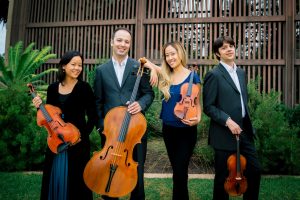Hausmann Quartet Champions New Works
Opening their concert in the Conrad Prebys Aztec Student Union Theatre with the premiere of Linde Timmermans’ “Cante de Ida y Vuelta,” a work written for the Hausmann Quartet, set a high standard for the evening. The premise of her work celebrates the connection of songs and dances from South America as they migrated to Spain, the non-indigenous culture that most influenced that Southern hemisphere. Aptly, Timmermans translates her title as “roundtrip songs.”
Her quartet’s austere idiom—short, incisive motifs treated soloistically—struck me as an homage to Anton von Webern, or perhaps what that astringent Viennese composer’s string music might have sounded like had he been Spanish. Although Timmermans marked her work in four separate movements, her sonic landscape was filled with so much silence, it sounded like a longish single movement.
I did catch the rhythmic pulse of the third movement Milonga, traditionally a slow Argentine tango, as well as the last movement’s robust Petenera, an Andalusian flamenco genre, which the composer gave to the cellist Alex Greenbaum as a cadenza-like solo. Oddly, the other three musicians tucked their instruments into their cases as he passionately played on to the final cadence.
Two works by Yale Strom, the university’s Artist-in-Residence of Jewish Studies and noted klezmer performer and researcher, followed. A dark, modal duet for violin and cello, “Gilgulim” fused the unrelenting pulse and haunting melancholy of eastern European klezmer song with acerbic contrapuntal accents. A single movement from his string quartet “Di Fusgeyers” (Yiddish for “The Trekkers”) alluded to the neighboring musical cultures middle European Jews encountered as they migrated on foot to ports in northern Germany in order to immigrate to North America during the first decade of the 20th century. Violinist Melody Chang played a bold, haughty Magyar tune with flare and evident assurance in this majestic piece that suggested a determined procession or improvised march.
Is there a string quartet more beloved than Antonin Dvorak’s F Major Quartet, Op. 96, known as the “American” because he wrote it North America in 1893 during his three-year tenure as director of New York’s National Conservatory? Hausmann’s account of this string quartet proved warmly idiomatic, exuding the generous spirit for which this Czech composer is celebrated. Their opening movement sparkled, and the broad, nobly paced Lento featured ardent and richly hued solos by Greenbaum and violist Angela Choong. The Scherzo could have used a more muscular, driving pulse, and the in finale, first violinist Isaac Allen appeared to be following his colleagues rather than leading them to victory.

Ken Herman, a classically trained pianist and organist, has covered music for the San Diego Union, the Los Angeles Times’ San Diego Edition, and for sandiego.com. He has won numerous awards, including first place for Live Performance and Opera Reviews in the 2017, the 2018, and the 2019 Excellence in Journalism Awards competition held by the San Diego Press Club. A Chicago native, he came to San Diego to pursue a graduate degree and stayed.Read more…

